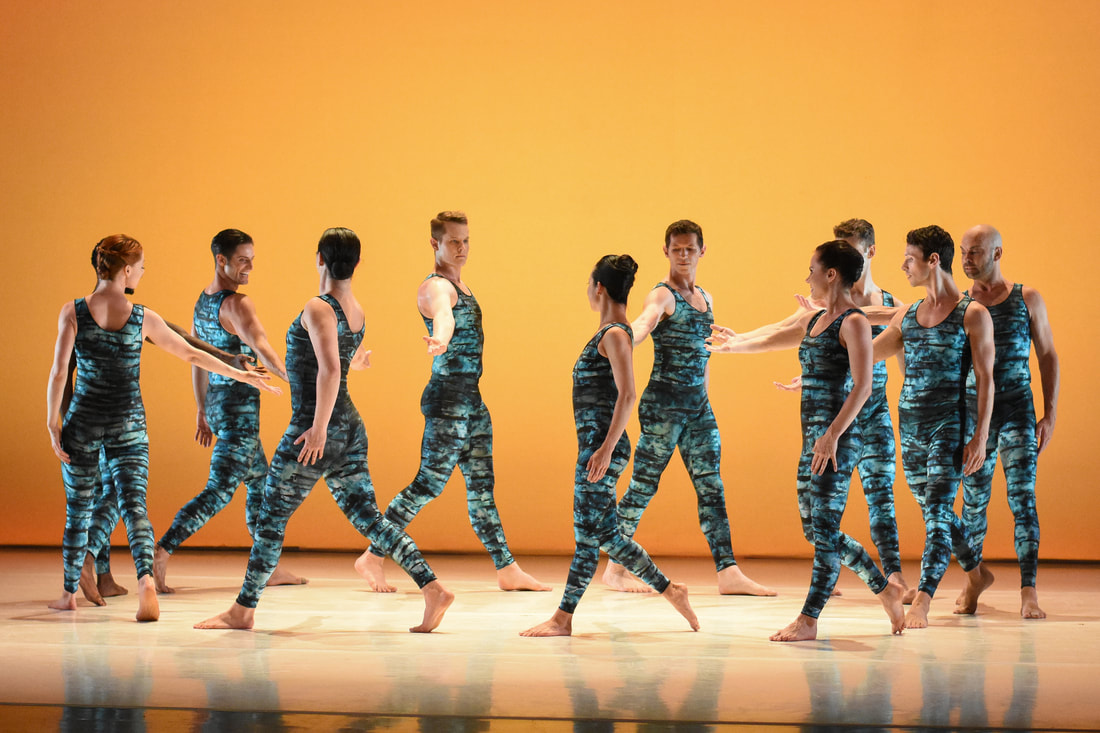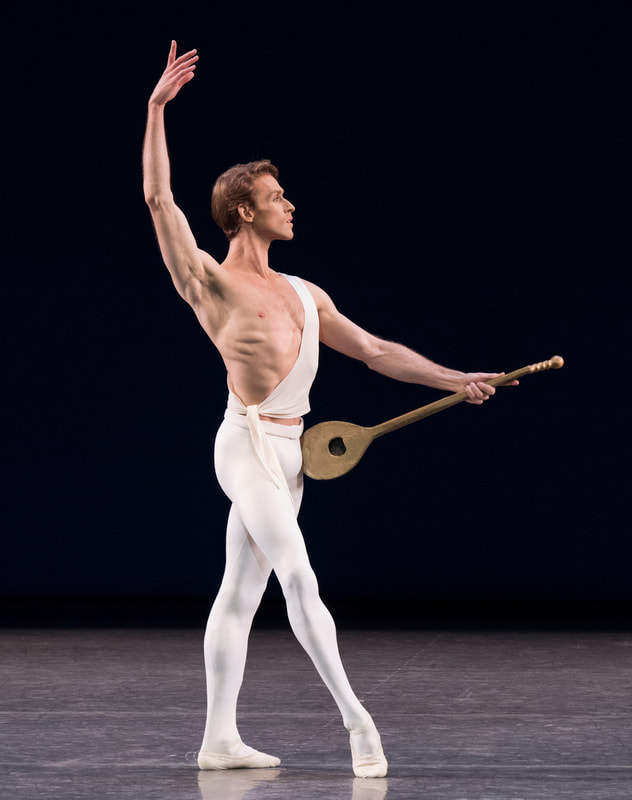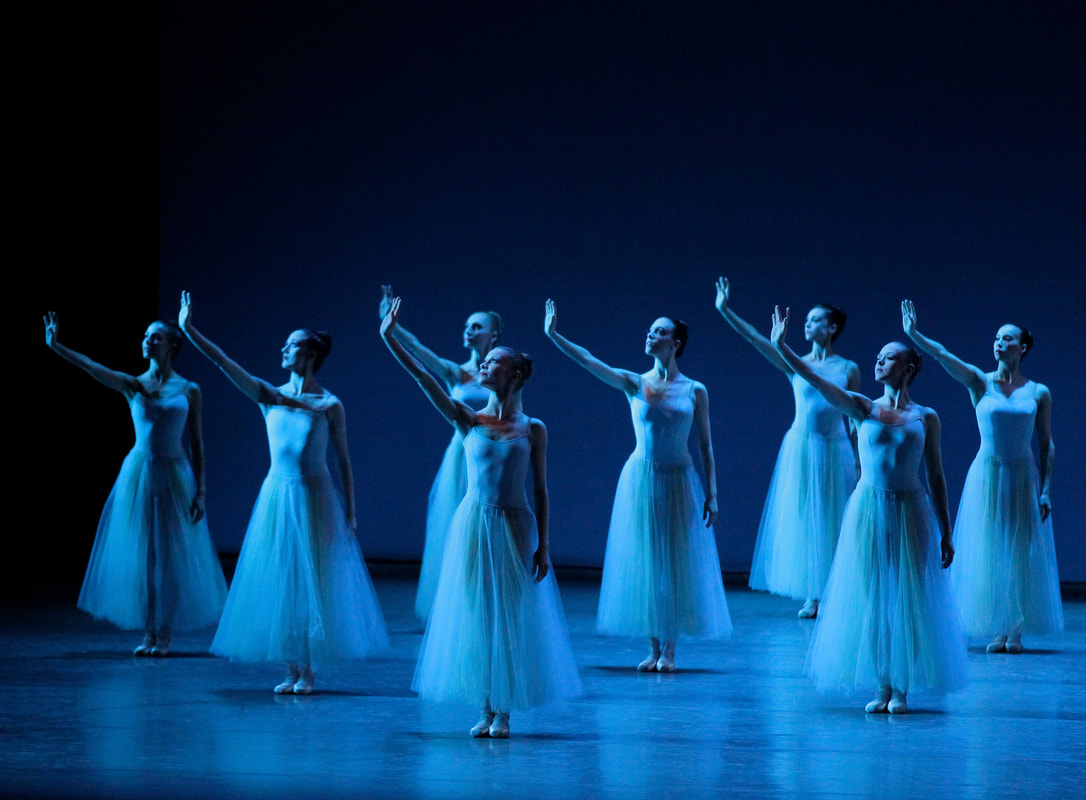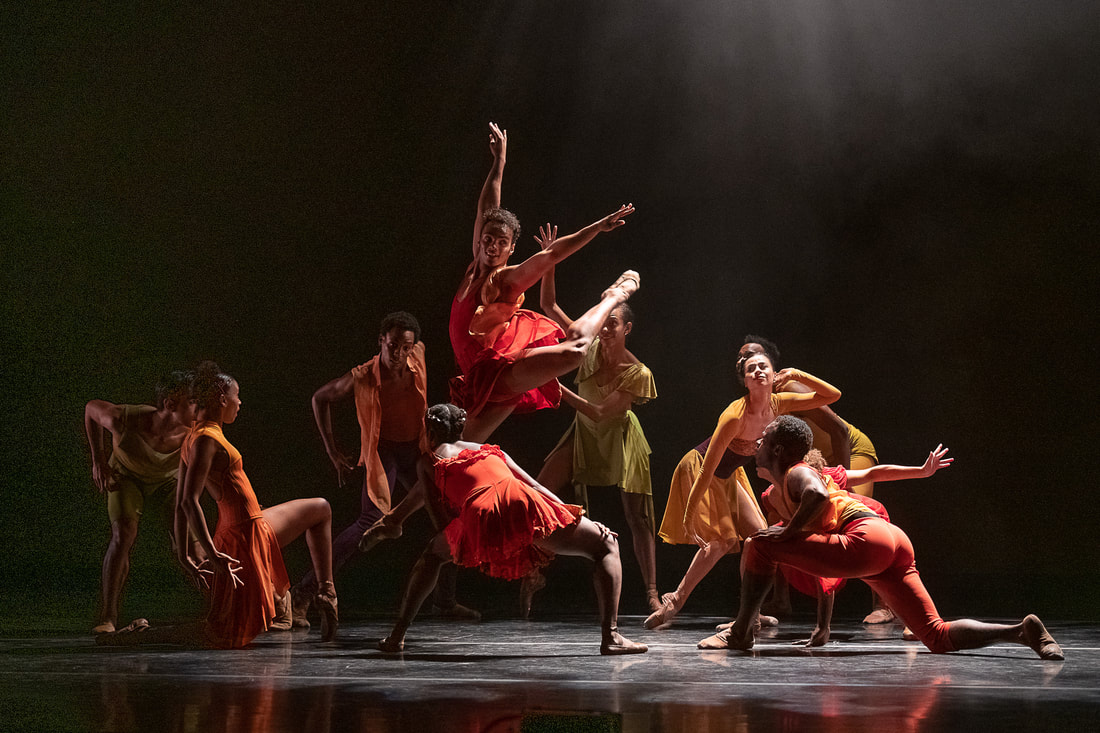|
Paul Taylor Dance Company in the choreographer's final work before he died, "Concertiana." When Paul Taylor died last year, there was a fear that the vessel for his work – the Paul Taylor Dance Company – would die with him. It’s not an unfounded anxiety. Taylor was the creative breath that filled the company’s lungs –producing the movement that enchanted both dancers and audiences for more than five decades.
As seen on Wednesday night at Jacob’s Pillow, the Paul Taylor Dance Company instilled hope as much as it did concern about its ability to endure. Now under the direction of veteran dancer Michael Novak, the company appeared tentative and nervous. The bold abandon, that I used to enjoying while watching the company, was, at times, insecure, uncertain. It was most obvious in the first work -- the classic “Aureole.” The beautiful joyous work, seen at the company’s first showing at the Pillow in 1964. With the dancers dressed in white and moving to excerpts from Handel’s “Concerti Grossi in C, F” and “Jephtha,” the five looked on edge and nervous. That transferred to audience, which was apprehensive until the final work, “Promethean Fire,” when the company finally appeared to settle. I was most surprised by Robert Kleinendorst and Michelle Fleet, two senior members. They looked stiff and uncomfortable. (It was at that moment that I longed to once again see Michael Trusnovec, whom I adored. He retired after 21 years of dancing with the company just last month.) I hope no one judges “Aureole” from this performance as it did not inspire the infectious jubilation for which it is known. The program moved on to "Concertiana,” Taylor’s last work. At that point, the evening started to radiate the Taylor company glow. Much has to do with Taylor’s masterful choreography. The George Balanchine of modern dance, he artfully deployed dancers in endless captivating patterns that kept the eye alert and interested. Yet “Concertiana,” to music by Eric Ewazen, also revealed Taylor’s mindset at the end – one that was angrily staring down death and then willingly surrendered to it. It was both frightening and beautiful as dancers passed in silhouette upstage and swarmed around like angels before being swept into a final ecstatic journey. The evening ended with one of Taylor’s more moving works – “Promethean Fire.” Said to be inspired by the horrors of 9/11, the work has the dancers fleeing and falling in a portrait that appeared both chaotic and orderly, replete with images of heroics and death. It’s all so Taylor. He had an uncanny ability to enthrall audiences as much as ground them in the reality of our troubled world. He will be sorely missed. I do hope that the company, which will dance through Sunday at Jacob’s Pillow, lives on.
0 Comments
Adrian Danchig-Waring as Apollo The New York City Ballet Gala at Saratoga Performing Arts Center is often more about being seen than seeing ballet. It’s a complaint I’ve been making for years and while it has gotten better (I no longer see drunks throwing up in trash bins) the audience still can act more like they’re at a ball game than a ballet.
That said, City Ballet’s program at Saturday’s big fundraiser was enough to pause some of the restless audience giggling and chatter. The respectable and eye-catching program started out with one of George Balanchine’s masterpieces – “Apollo.” This Stravinsky-inspired ballet, Balanchine’s first with the composer most closely associated with him, is always a delight to see because it exposes the artistic maturation of the company’s highest-ranking male dancers. On Saturday, it was the striking figure of Adrian Danchig-Waring. The ballet is a coming of age story for Apollo, the young god, who frolics and is nourished by three muses – Sterling Hyltin as Terpsichore, Brittany Pollack as Polyhymnia and Indiana Woodward as Calliope. (Of course he prefers the goddess of dance, Terpsichore.) Yet the women’s roles are secondary to the title role, which Danchig-Waring performed with a vigor that was tinged with a boyish naivete, so befitting for Apollo. He’s flexing his muscles, quite literally, with a trio of adoring females who also care for him – holding his head when he tires as well as feeding his ego as they cling to him on his journey to the heavens. The ballet is essential for all those who love metaphorical imagery because the work moves from one compelling pose to another. It opens with Apollo swinging his arm to crudely play a long-necked lute. The muses approach him reverently, kicking their long legs upon entering his realm and, when reaching him, forming a crown on his head with their hands. They fall under his spell, allowing him to pose, divide and unite them. They are his team of horses, they are his playmates and in the end his starburst in the sky. Danchig-Waring was equal parts sweet and strong, but not yet a standout. As he performs it more, he will surely grow more compelling in the role. The evening proceeded with a surprise – Ashley Bouder and Joseph Gordon performed the celebratory final pas de deux from “Coppelia” to make up for the ballet's cancelation on Saturday afternoon due to the excessive heat. Bouder, as always, was purity as the young bride. I am always amazed by her zest and her exquisiteness. Bouder is a supreme pleasure. Christopher Wheeldon’s sobering “This Bitter Earth,” another pas de deux, was also excellent. While I can never erase the original ballerina, Wendy Whelan, from my mind’s eye as she was the part, Sara Mearns was distinctive. Dancing with the sensitive Tyler Angle, Whelan’s original partner, Mearns had a juicy quality that exuded a thoughtful elegance that was just right for the somber work. The evening ended with Justin Peck’s “Principia” to a commissioned score by Sufjan Stevens. As always, Peck came up with some memorable moments – the beginning and ending most notably. But the music did not allow for one central theme to emerge, which meant that the choreography lost its momentum in several spots. Unfortunately, it is not Peck’s best. More unfortunate, “Principia” was the final image that City Ballet fans were left with as the short five-day stay is sadly over. Megan Fairchild owns the title role of "Coppelia." “Coppelia” has come home -- at least for New York City Ballet fans at the Saratoga Performing Arts Center that’s how it feels.
The comedy, choreographed by George Balanchine and Alexandra Danilova, represents City Ballet’s heyday at SPAC – a time when the company spent multiple weeks in the amphitheater and when the venue could afford to commission such a grand spectacle. Balanchine’s rendering of this 1870 classic made its world premiere at SPAC in 1974 and it feels like a homecoming each time it returns. Moreover, the evening-length ballet with music by Leo Delibes is the perfect creation, one that will tickle those who are regulars and the youngest and newest of fans. Much is due to Megan Fairchild, who on Thursday night, reprised her role as Swanilda, the jealous betrothed of Frantz who likes to flirt with a doll named Coppelia. Of course, he doesn’t realize it’s a doll until Swanilda and friends invade the toymaker’s workshop and discover Coppelia’s soulless identity. That leads to a series of silly scenarios including Swanilda posing as the doll after the toymaker unexpectedly returns to the workshop and discovers her there. Fairchild has been dancing Swanilda since 2003, debuting in the role at SPAC after two other ballerinas were injured. Though only a soloist at the time, Fairchild owned “Coppelia,” which obviously help propel her way to principal just seven months later. (This fact enhances the special connection that she and “Coppelia” have to local audiences.) It’s an exhausting title role as she is onstage nearly every second in the first two acts. The impish Fairchild is marvelous, however, as she pours all she knows about drama and comedy into the role. Technically, she is flawless too. Her Frantz was the ebullient Anthony Huxley who was unstoppable. His variations in the finale pas de deux expressed overflowing joy over his marriage to Swanilda. The ballet, with scenery by Rouben Ter-Artunian, is beautiful too. The pastel village square, with giant bells overhead and touches of pink to accent Swanilda’s skirt, was adorable. So too were the many local children who performed in the third act of the ballet. As always, they were well-rehearsed and on point thanks to the Children’s Ballet Master Dena Abergel and her associate Arch Higgins. “Coppelia” will be repeated tonight and Saturday afternoon. I promise it will delight. Taylor Stanley is a standout in "The Runaway," a new work by Kyle Abraham. “The Runaway” signals a new era for New York City Ballet.
The ballet, choreographed by Kyle Abraham, the first he has ever created for a ballet company, means that the company is catching up to world. And, with the departure of the disgraced Peter Martins, the company will no longer bristle from the territory that ballet now treads – hard and edgy, dark and relevant. The years of fairy tales of poetic dreamers pursuing the idealized feminine beauty, though popular with audiences, no longer inspires choreographers. Today’s dance makers are living today and reflecting today. And to see it finally seep into the hallowed halls of New York City Ballet is refreshing. Everything about “Runaway,” which made its Saratoga Performing Arts Center premiere on Wednesday night, surprised. The black and white costumes, designed by Giles Deacon, were outlandish: Peter Walker’s collar obscured his face and Sara Mearns and Georgina Pazcoguin, nearly unrecognizable in black spikey wigs. Yet what was most surprising was the music – mainly from the Kanye West song book. The ballet started with “Quiet Music from Three Etudes” by Nico Muhly for piano and violin. Then the lights went dark in the orchestra pit and West along with voices of Jay-Z and James Blake reverberated, showing ballet is not just about beauty. The star of the piece was the prodigious Taylor Stanley. His opening solo, in which he appears more avian than human, was riveting. Stanley has a supernatural ability to pour so much more into every movement. When Stanley dances, the audience doesn’t just see a body; it sees a soul. “The Runaway” is made up of some extraordinary and funky solos, duets and trios. The bouncing and spinning Spartak Hoxha in “I Love Kanye” was eye-popping. Ashley Bouder was ideal for the whole affair as she personifies today’s dancer – able, strong and unstoppable. There was a lot to see in the ballet that it requires several viewings to take it all in. The same can be said for Justin Peck’s “Principia,” which also had its premiere at SPAC. The work, set to a commissioned score by Sufjan Stevens, a favorite composer of Peck’s, was rich with imagery that could be happily experienced again and again. Among them was the opening with the dancers clustered with individuals bursting from the huddle and then melting back down. The section where the dancers gather like haystacks, that when tapped, reveal another who flares freely to release another from a cluster was lovely. The incredible evening opened with yet another SPAC premiere, Jean-Pierre Frohlich’s “Varied Trio (in Four).” Set to music by Lou Harrison, the ballet is a duet with the trio, pianist Alan Moverman, violinist Kurt Nikkanen and percussionist James Baker, onstage. Sterling Hyltin danced the pas de deux with Amar Ramasar, who recently returned to the company after City Ballet was order to reinstate him after he was fired for sending explicit texts of a fellow dancer. Hyltin and Ramasar performed this cool and robotic pas de deux with calm and precision. Sadly, as it was the first time seeing Ramasar, all I could think of was what he was accused of doing. He has always been a favorite of mine – mainly because he elicits so much joy in dancing. He often can’t hold breaking into his well-known jaunty smile. I’m not sure that the dancer he allegedly harmed can move on. But I hope I can and take pleasure in Ramasar’s gifts once again. New York City Ballet in "Serenade." There is no better pairing of a composer and choreographer than Pyotr Ilyitch Tchaikovsky and George Balanchine.
While they were not contemporaries, Balanchine devised some of his most sublime works to the soaring, romantic music of the great ballet composer. And on the top of the list is “Serenade.” The ballet was a superb opening on Tuesday night for New York City Ballet’s ever-shrinking stay at the Saratoga Performing Arts Center. It was also a wonderful welcome to the large crowd that greeted the company with cheers the moment the curtain opened. There is no doubt, Saratoga loves City Ballet and its orchestra. “Serenade” was among three ballets, “Mozartiana” and “Tchaikovsky Piano Concerto No. 2,” included, that Balanchine created to Tchaikovsky’s swelling scores – all of which were performed with gusto by the beloved City Ballet orchestra. The moving “Serenade” was the star. The all-blue ballet, with the long tutus now hinting a streak of yellow, can be a religious experience. Lauren Lovette, cast as the ballerina who ascended to the heavens, was ideal for the role. Her tiny frame lent her a vulnerability and sweetness that deepened the experience for those in the seats. Equally wonderful was Ask LaCour has her fleeting suitor and Preston Chamblee, as the blind angel of death. But what makes this ballet so wonderful, is its iconic opening tableau – a bevy of ballerinas with their palms pressed to the sky and then their arms melting over the heads just before their feet flick to first position. The ending is equally memorable -- a ballerina, in this case Lovette, is touched by the angel whom she dances with before she collapses. The ballerina is then lifted by her ankles and arches her back, chest to the sky, as if surrendering her soul to something larger. Balanchine created the ballet in 1935, his first in America. It appears he poured all his knew about ballet and Tchaikovsky into it and it will surely be a treasure for decades to come. “Tchaikovsky Piano Concerto No. 2” was almost as wonderful. Susan Walters fiercely attacked the score on the piano while the dancers surged and scattered in large intriguing patterns – the kinds of designs that only Balanchine could create. Teresa Reichlen and Russell Janzen held sway as the princess and her dreamy suitor. So too did Lauren King who lit up the stage with her posse, Sara Adams and Indiana Woodward. For such a formal work, with many bent-kneed proposals, Balanchine kept the dancers moving and moving quickly through to a finish that sparkled. “Mozartiana,” which is also ceremonial, was a little disappointing. The opener, Preghiera, with the young ballerinas and prayerful Sara Mearns was gorgeous. As usual, Daniel Ulbricht was a dynamo in the Gigue. But the Theme et Variations with Mearns and Tyler Angle looked belabored. Mearns can do anything, but looks her best as an adagio dancer. Angle was fine, hitting the complicated entrechat, but appeared overly winded at the end. The young local students, Amelia Blackwood, Eliana Lomanno, Julia Ross and Avery Walz, were perfection, just like the rest of the evening. Welcome back New York City Ballet. Dance Theatre of Harlem entertained from start to finish in Annabelle Lopez Ochoa's "Balamouk." What’s not to love about Dance Theatre of Harlem?
The company of artists is likable, accomplished and they have a backstory that is inspirational. They were founded by New York City Ballet principal Arthur Mitchell right after the assassination of Dr. Martin Luther King Jr., to prove to the world that black dancers not only can do ballet, but can excel in it. (Anyone who saw the elegant Mitchell dancing in the 1960s already knew that. But many didn't. Unfortunately, the race issue persists today.) That solid foundation, built by an exceptional artist, propelled the DTH through some very lean years. Now, celebrating their 50th anniversary and led by former DTH superstar Virginia Johnson, DTH is showing off its chops on the venerable Jacob’s Pillow stage. (The will dance there through Sunday, July 14.) The 16-member company’s foundation is rooted in George Balanchine, the creative genius who recognized the late Mitchell’s potential. Among the works performed at the Pillow is Balanchine’s swirling “Valse Fantaisie” to Mikhail Glinka’s Valse Fantaisie in B minor. While the neoclassical waltz was lovely, with dancers donning emerald-colored romantic tutus and flowers in their hair, the artists looked the most comfortable and competent in the contemporary works – mainly Christopher Wheeldon’s “This Bitter Earth” and Annabelle Lopez Ochoa’s “Balamouk.” Anyone who has seen “This Bitter Earth” knows that it’s one of Wheeldon’s best pas de deux. The British choreographer has an ability to create a connection between his dancers that is meaningful and in this case melancholy. Dylan Santos with Crystal Serrano grabbed hold of the inherent emotions in this brief ballet. He was exceptional as he met her eye-to-eye with foreheads touching or as he spun her in his arms. He drew out the gravitas of the work. Serrano, unfortunately, did not take advantage of the richness of its context, at least not at first. But the work was still moving and emotionally raw, thanks to Santos’ sober poise as well as the rich music by Max Richter overlaid with Dinah Washington’s wistful words. “Balamouk,” while uneven choreographically, showed off the skills of these ambitious and versatile dancers. The colorful work stunned from the moment the curtain rose with the dancers in dim, smoky stage moving like one. Assembled with solos, duets and daring group dances, “Balamouk" built on the unique music: jazzy/Klezmer sounds Les Yeux Noirs supplemented with the otherworldly pull created by Lisa Gerrard and the lively tones by Rene Aubry. The stylish work, which was under the haze of a worldly vibe, skittered across the stage, entertaining from start to finish. Some of the transitions were awkward, but the dancers did their best with all that they were given. The program opened with Darrell Grand Moultrie’s “Harlem on My Mind.” Set to jazz standards like “Ain’t Misbehavin’” and “It Don’t Mean a Thing If It Ain’t Got That Swing,” the dance signaled that DTH was here and setting the stage on fire. Bravo DTH! Ronald K. Brown: Evidence performed its amazing "Grace" at Bard College's Fisher Center. Going to a Ronald K. Brown/Evidence: A Dance Company can often feel like going to church. Artistic Director Brown always infuses a spiritual component, one that asks the dancers and the audience to recognize the magic of the divine in the world in which we struggle.
Sunday’s showing of “Grace” and “Mercy,” at Bard College’s Fisher Center for the Performing Arts, is a prime example. Both works are like prayers, “Grace,” a robust praise, and “Mercy,” a quiet hymn. I preferred “Grace,” which for the Bard showing was reworked to include to the infectious sounds of Peven Everett. His vocals and the rambunctious blends of jazz and R&B elevated this already blockbuster of a work to one that sent its 13 dancers and the audience soaring to the heavens. The worked opened with a dancer parading directly center stage from an opening between musicians. Dressed in white, she invokes a call to God to watch over her people – and with a tap to her heart, she reaches and jumps straight up as if to capture a ride on the invisible wings of angels. As the music builds, dancers join her. Dressed in either white or red, they swagger in and out, offering some gesture of devotion or celebration before sauntering away again. Appearing super cool, they move in and through well-defined moving lines. The constantly shifting of patterns kept the audience riveted. Everett and his tight band along with singer Gordon Chambers also held sway. Their giant talents and honesty touched everyone in the room – bestowing on Brown’s “Grace” a punch that it couldn’t have achieved otherwise. The work was so inspiring that it stole the limelight from “Mercy,” a world premiere that followed. While that too was accompanied by lofty live music, performed by its ingenious composer Meshell Ndegeocello, the piece felt humdrum. Part of the problem is Brown’s movement vocabulary, which is limited. The dancers are essentially performing the same dance – "Mercy" is more subtle of course – to different music. While narrow in scope, Brown's style is uniquely his. A seamless blend of African and modern dance, his brand is instantly recognizable. It’s also appealing, in a sweet, heart-felt way. However, I often leave a Brown performance feeling that the choreographer leans too heavily on the music, asking it to distinguish the personality of the dance -- rather than allowing the dance to reveal itself. A work like “Grace” is so captivating that it hardly matters. “Mercy,” unfortunately, is another case. |
Wendy
|







 RSS Feed
RSS Feed
